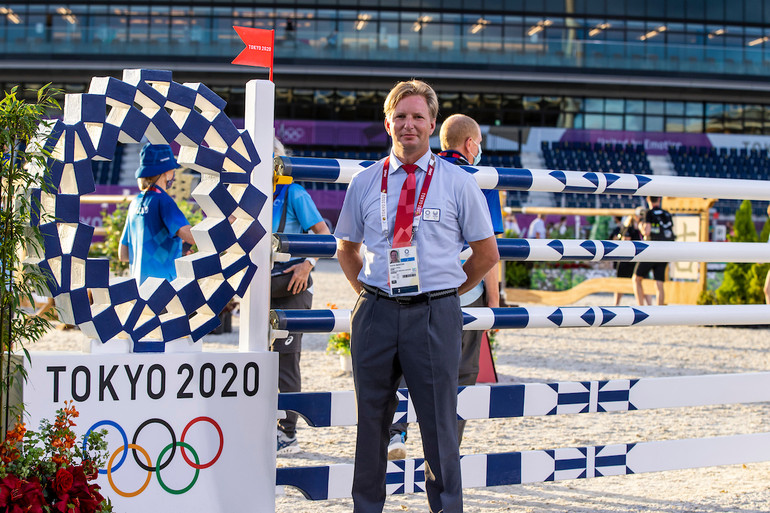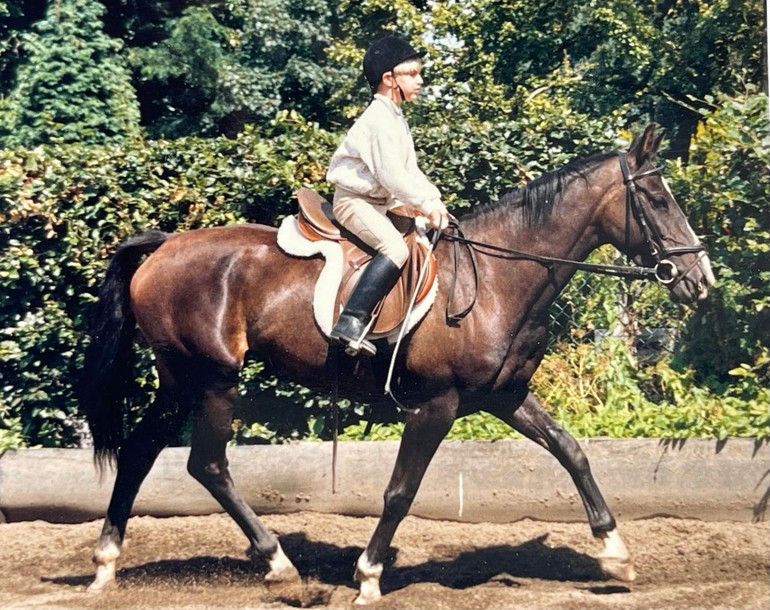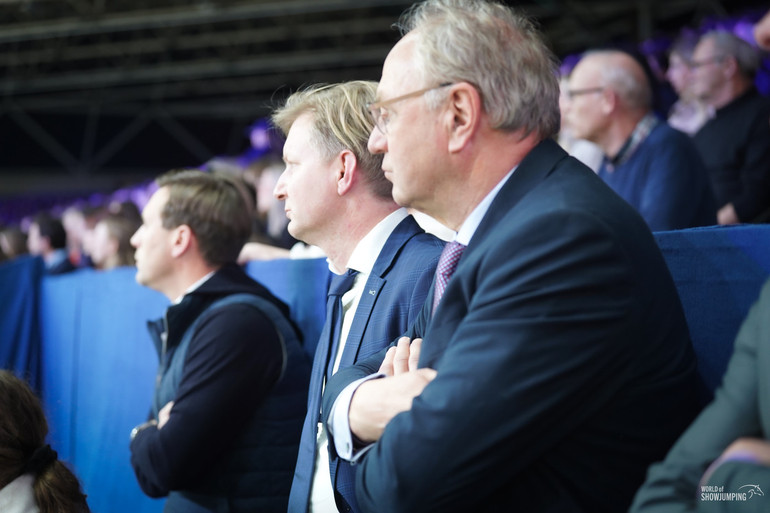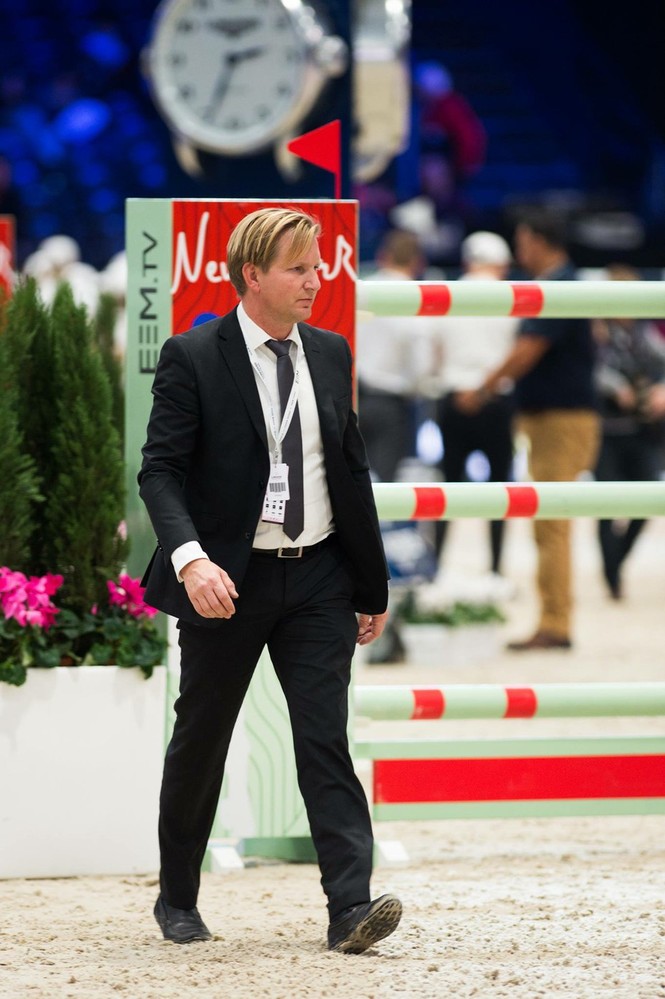Text © World of Showjumping
“The multifaceted aspect of course design is what really intrigued me,” Quintin Maertens, a Dutch level three course designer, tells World of Showjumping. “I have to work with people, and combine creativity with the technical part as well as with horsemanship. My gratification comes from doing the work with the team.”
“Making a living with course design has never been my main goal. I have walked parallel paths for the last two years: I started a small company with my brother when I began to feel uneasy about the direction our sport is taking,” Quintin explains. “None of us is entitled to earn a living with horses; I believe it is a privilege and something that should be cherished, but not treated as the root of our sport.”
Drawn to horses
Even though Quintin does not come from a horsey family, the 45-year-old has been drawn to horses since he was little. “Before I could walk, I always wanted to go to the ponies,” he recalls. “It's something I was born with. Since we had no equestrian knowledge in my family, I started to gather all the information I could.”
None of us is entitled to earn a living with horses; I believe it is a privilege and something that should be cherished
Later on, Quintin’s curiosity led him to a seminar about course design. “I joined, not because I had big goals of becoming a course designer, but because I wanted to learn. Louis Konickx was one of the guest lecturers and that is the first time I met him. After the seminar he asked if I wanted to follow along to the Dutch Championships. I went – and got bitten by a course designing bug.”
With roots in Zimbabwe, Quintin’s goal was always to return to Africa and have a big farm there – just like his uncle. “The continuous political unrest in Zimbabwe changed my plan,” he explains. “I had started veterinary studies and actually focused on bovine medicine. When I wasn’t able to go back to Africa due to the war, I switched to horses. I was not interested to work with the dairy cattle in the Netherlands. As I was riding at the time, I bought a farm and started to produce young horses. I did that for quite a long time, more or less successfully.”
Under the wings of Arno Gego and Louis Konickx
When Quintin in 2008 sustained an injury that made riding impossible, he focused more on course design. At a seminar organised by the Dutch Course Designers’ Association, he met Professor Dr. Arno Gego. “Arno took me under his wing like Louis had done before. I did many shows with the Aachen School of Course Design. It was character building at times, but I learned a lot. Arno and Louis have for sure been my biggest influences.”
It was character building at times, but I learned a lot
In 2017, Quintin and Louis decided to join forces again and have worked as a team ever since. “We bring out the best in each other,” Quintin explains. “We have the same kind of humour and work ethic; we complement each other very well. However, there is also healthy competition between us: If I have an idea, he'll try to make it better. Often, the course plans get sent back and forth a couple of times before they are finished.”
Due to the increased amount of prize money on offer and the professionalism in the jumping sport, there is a lot of pressure on the course designer, Quintin explains. “When you have the final responsibility, you are not as free to be creative,” Quintin points out about the difference of being named a course designer or an assistant course designer. “The responsibility does weigh on you. It's not a big nuisance, but you feel that you're not as free as the assistant next to you. On paper it might seem like there is a big difference between the course designer and the assistant, but neither me or Louis has an ego that needs to be in a spotlight. We both want to have the best product in the end and there is a warm atmosphere between us.”
Building for the best while accommodating for the rest
“It's getting more and more difficult,” Quintin says about the challenges of designing courses for the high level of competition between the best horse-and-rider combinations in the world today. “The more you do, the harder it gets because you want to create something new every time. You want to bring in something creative but you also know what works and what doesn't. I think it's very important to have beautiful sport, to show off the beauty of horses and the harmony between the rider and the horse. However, at the same time we have to create exciting sport and produce the right result. As a course designer, I want to feel secure that we get a good result in a fair way. It's very challenging: You try to put the odds in your favour with your design, but in the end it's always like rolling a dice.”
I think it's very important to have beautiful sport, to show off the beauty of horses and the harmony between the rider and the horse
“The sport needs to accommodate to them, no matter how they got there,” Quintin says about the less experienced riders who pay to compete at a higher level. “Whether it is us course designers or the organisers, they need to be accommodated for. There are a couple of things that we as course designers can do when we have a varied starting field. For me, the most important aspect is always that the horses can get to the finish line safely. With this in mind, for example on the first days at championships and finals, we should not be too extreme with the height or spread of the obstacles when the weaker riders are still involved. There is the time element as well, which you can use to allow the better riders to set themselves apart from the less experienced combinations. Also, if a horse-and-rider combination has time to see a jump or a line coming, it gives them the opportunity to prepare for it and then at least the horse will not be surprised. Small details like giving them one extra stride into a difficult line or a bit more time in general, can help everyone stay safe. You might get more clear rounds this way, but I think both Louis and I are similar in this regard: We would rather stay on the safe side and filter out later.”
Commercial enterprise or sport?
Seeing commercial interests take hold of a sport with many unique aspects and a lot of tradition is something Quintin struggles with. “Our sport has become an industry,” he reflects. “Perhaps we have lost the art aspect of it. Working with horses and having a harmonious connection with them has always been something very fundamental, something special. For me, the bond between a human and a horse and the sport itself have always been something magical. The last couple of years, seeing everything become so commercial, I feel like a part of the magic has been lost. Sometimes I feel more like part of a commercial enterprise than a sport – and it is a role I am not sure I want to play.”
Seeing everything become so commercial, I feel like a part of the magic has been lost
“I used to do a lot of course designing when I was still honing my skills,” Quintin continues. “I used time and effort to learn and gather the knowledge and confidence to be able to do this job. However, the way our sport has evolved has made me hit the brakes. I have started to dislike the commercial aspect and it is something I cannot unsee anymore. It's more and more about money and extravagance and less and less about horses. Sometimes it seems like our sport is being turned into a product that can be sold.”
Fear of failure
When asked about the education of officials, Quintin points out another issue he has noticed: “Education is not only about rules and dry theory, and I think this aspect is neglected at the moment. Lately, it feels like our sport is held in an iron grip through rules and regulations. Of course those are necessary but to me it’s over the top at the moment; too much bureaucracy drowns good intensions. I think this approach gives real horse people less opportunities to do what should be done. Simultaneously, people who don't have the talent or the right mentality can get to places they probably shouldn't go, only because they tick the right boxes.”
Too much bureaucracy drowns good intensions
"I believe that instead of more forms and regulations, we need good people who have experience and the guts to intervene when needed and simply say ‘you cannot do this’. If we need rules to back them up by the system then so be it, but it should start with having the right people. I understand that such an approach is dangerous, because then all of us have to depend on those people, on their judgement and on their morals. Sometimes it feels like there is not enough trust anymore – in my opinion, the excessive rules are pointing towards that. There seems to be such a fear of mistakes that an air tight organisation is built and it is being sealed with regulations. In the end, it might prevent legal liability, but I question if it does anything for the sport.
There seems to be such a fear of mistakes that an air tight organisation is built and it is being sealed with regulations
“It is only logical that there is tension about decisions when the commercial aspect is mixed with the FEI’s main role as a governing body,” Quintin points out. “From the outside, it feels like there is friction between commercial goals and the FEI’s role as guardian of the horses and the true sport. I guess opportunism is in the human nature, and therefore, we do need a strong governing body.”
It feels like there is friction between commercial goals and the FEI’s role as guardian of the horses and the true sport
“With the current voting system, it is a difficult task to build trust and make the true stakeholders in our sport feel like they are part of the decisions made,” Quintin says about the voting system the FEI has in place at their General Assembly, where each of the 136 national federation has one vote, regardless of their activity in the sport. [Editor’s note: In April 2024, 38 NFs from 136 had zero horses registered in the FEI database, 21 had zero athletes registered and 70 organised zero FEI events] My main problem with this is that ultimately, nobody can be held accountable. I think this a fundamental issue because anything you build on top of that will be unstable.”
Have some heart
Despite his worries for the future, Quintin believes that there are a lot of people involved who live for the sport. “Everyone has to make a living, but I believe that there are many riders who value the honour and the medals and simply appreciate a life with horses," he says.
In general, we should care more about the horses and less about the VIP tent
“It should be about the horse again,” Quintin says when asked what kind of change he would want to see. “Some of the locations where we bring horses for competition purposes almost feel disrespectful towards them as the animals they are. Simultaneously, I think it's a shame that we are losing some of the shows on grass. Some of the traditional shows cannot compete with the money on offer at the new extravagant venues. In general, we should care more about the horses and less about the VIP tent. I understand that we need the VIP, but we should not neglect the true selling point of our sport; the horse.”
We should not neglect the true selling point of our sport; the horse
“There are parts of the sport I will always enjoy,” Quintin concludes. “I still get goosebumps when I see a good horse and good sport. Seeing that there is still heart and passion in the sport keeps me going. Tens of thousands of people come together in Aachen every year, waving little white handkerchiefs. I want to believe that they are there for the horses, that they feel it is about sport and not about money. We should not lose this magic that pulls people into our sport and keeps everyone – myself included – motivated. Passion rubs off on everyone and I think that's the power of our sport.”
28.5.2024 No reproduction of any of the content in this article will be accepted without a written permission, all rights reserved © World of Showjumping.com. If copyright violations occur, a penalty fee will apply.















